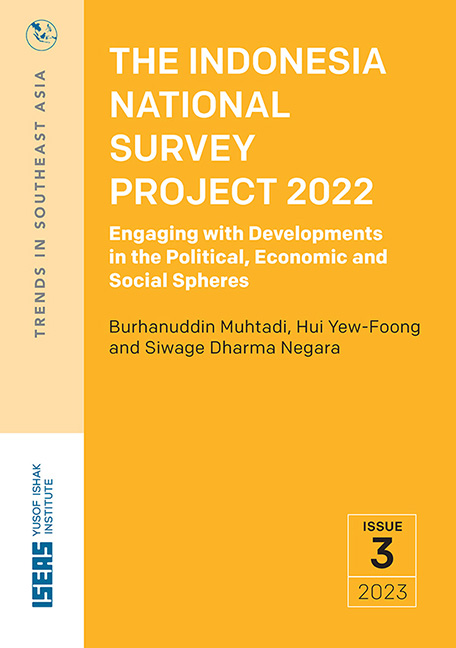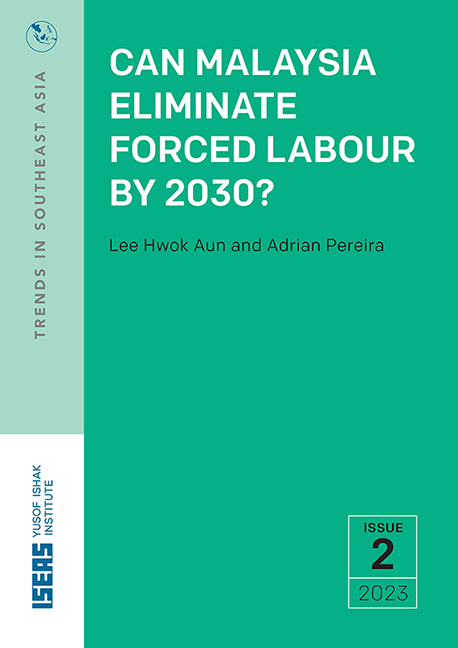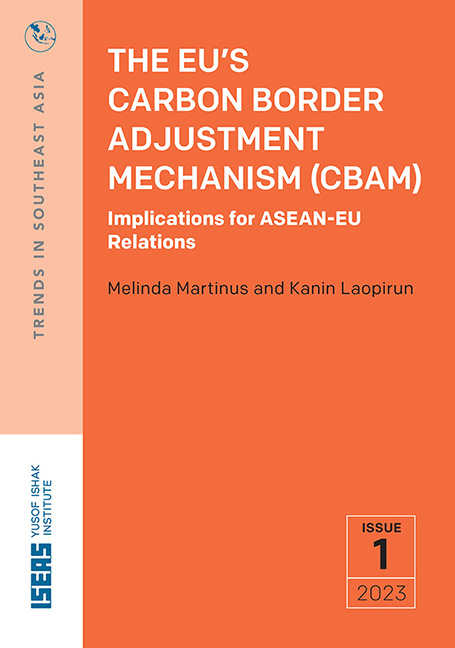Refine listing
Actions for selected content:
15726 results in ISEAS-Yusof Ishak Institute

The Indonesia National Survey Project 2022
- Engaging with Developments in the Political, Economic and Social Spheres
-
- Published by:
- ISEAS–Yusof Ishak Institute
- Published online:
- 09 January 2024
- Print publication:
- 28 February 2023

GVC Reconfiguration
- Risks and Opportunities for ASEAN Members
-
- Published by:
- ISEAS–Yusof Ishak Institute
- Published online:
- 09 January 2024
- Print publication:
- 03 March 2023

Explaining PAS's Dominance in Kelantan
-
- Published by:
- ISEAS–Yusof Ishak Institute
- Published online:
- 09 January 2024
- Print publication:
- 24 November 2022

'Stanning' Najib
- Fanning a Personality Cult in Malaysian Politics
-
- Published by:
- ISEAS–Yusof Ishak Institute
- Published online:
- 09 January 2024
- Print publication:
- 20 December 2022

Tides of Insecurity
- Vietnam and the Growing Challenge from Non-traditional Maritime Threats
-
- Published by:
- ISEAS–Yusof Ishak Institute
- Published online:
- 09 January 2024
- Print publication:
- 03 March 2023

Can Malaysia Eliminate Forced Labour by 2030?
-
- Published by:
- ISEAS–Yusof Ishak Institute
- Published online:
- 09 January 2024
- Print publication:
- 07 February 2023

The EU's Carbon Border Adjustment Mechanism (CBAM)
- Implications for ASEAN-EU Relations
-
- Published by:
- ISEAS–Yusof Ishak Institute
- Published online:
- 09 January 2024
- Print publication:
- 07 February 2023
About the Contributors
-
- Book:
- Understanding the Role of Indonesian Millennials in Shaping the Nation's Future
- Published by:
- ISEAS–Yusof Ishak Institute
- Published online:
- 13 April 2024
- Print publication:
- 02 January 2024, pp xii-xix
-
- Chapter
- Export citation
Frontmatter
-
- Book:
- Understanding the Role of Indonesian Millennials in Shaping the Nation's Future
- Published by:
- ISEAS–Yusof Ishak Institute
- Published online:
- 13 April 2024
- Print publication:
- 02 January 2024, pp i-iv
-
- Chapter
- Export citation
List of Tables
-
- Book:
- Understanding the Role of Indonesian Millennials in Shaping the Nation's Future
- Published by:
- ISEAS–Yusof Ishak Institute
- Published online:
- 13 April 2024
- Print publication:
- 02 January 2024, pp ix-x
-
- Chapter
- Export citation
3 - Progressive Yet Powerless: The State of Indonesia’s Progressive Youth Organizations in the Post-Authoritarian Era
-
-
- Book:
- Understanding the Role of Indonesian Millennials in Shaping the Nation's Future
- Published by:
- ISEAS–Yusof Ishak Institute
- Published online:
- 13 April 2024
- Print publication:
- 02 January 2024, pp 70-98
-
- Chapter
- Export citation
List of Figures
-
- Book:
- Understanding the Role of Indonesian Millennials in Shaping the Nation's Future
- Published by:
- ISEAS–Yusof Ishak Institute
- Published online:
- 13 April 2024
- Print publication:
- 02 January 2024, pp vii-viii
-
- Chapter
- Export citation
List of Annexes and Appendixes
-
- Book:
- Understanding the Role of Indonesian Millennials in Shaping the Nation's Future
- Published by:
- ISEAS–Yusof Ishak Institute
- Published online:
- 13 April 2024
- Print publication:
- 02 January 2024, pp xi-xi
-
- Chapter
- Export citation
Introduction: Understanding the Role of Indonesian Millennials in Shaping a Nation’s Future
-
-
- Book:
- Understanding the Role of Indonesian Millennials in Shaping the Nation's Future
- Published by:
- ISEAS–Yusof Ishak Institute
- Published online:
- 13 April 2024
- Print publication:
- 02 January 2024, pp 1-9
-
- Chapter
- Export citation
7 - Youth and Religious Disaffiliation: A Study of Indonesian Millennials Learning Buddhism during Spiritual Disruption
-
-
- Book:
- Understanding the Role of Indonesian Millennials in Shaping the Nation's Future
- Published by:
- ISEAS–Yusof Ishak Institute
- Published online:
- 13 April 2024
- Print publication:
- 02 January 2024, pp 189-215
-
- Chapter
- Export citation
Contents
-
- Book:
- Understanding the Role of Indonesian Millennials in Shaping the Nation's Future
- Published by:
- ISEAS–Yusof Ishak Institute
- Published online:
- 13 April 2024
- Print publication:
- 02 January 2024, pp v-vi
-
- Chapter
- Export citation
4 - Indonesia’s Millennials and Gen Zs: Are They Financially (Il)literate?
-
-
- Book:
- Understanding the Role of Indonesian Millennials in Shaping the Nation's Future
- Published by:
- ISEAS–Yusof Ishak Institute
- Published online:
- 13 April 2024
- Print publication:
- 02 January 2024, pp 99-123
-
- Chapter
- Export citation
9 - The NFT Phenomenon among Indonesia’s Millennial Artists
-
-
- Book:
- Understanding the Role of Indonesian Millennials in Shaping the Nation's Future
- Published by:
- ISEAS–Yusof Ishak Institute
- Published online:
- 13 April 2024
- Print publication:
- 02 January 2024, pp 249-266
-
- Chapter
- Export citation
Index
-
- Book:
- Understanding the Role of Indonesian Millennials in Shaping the Nation's Future
- Published by:
- ISEAS–Yusof Ishak Institute
- Published online:
- 13 April 2024
- Print publication:
- 02 January 2024, pp 267-280
-
- Chapter
- Export citation
8 - Antagonism and Afterwards: Millennials in Indonesian Participatory Art after Reformasi
-
-
- Book:
- Understanding the Role of Indonesian Millennials in Shaping the Nation's Future
- Published by:
- ISEAS–Yusof Ishak Institute
- Published online:
- 13 April 2024
- Print publication:
- 02 January 2024, pp 216-248
-
- Chapter
- Export citation
